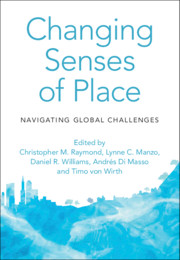Book contents
- Changing Senses of Place
- Changing Senses of Place
- Copyright page
- Dedication
- Contents
- Contributors
- Foreword
- Preface
- Acknowledgements
- Introduction
- Part I Climate Change and Ecological Regime Shifts
- Part II Migration, Mobility and Belonging
- Part III Renewable Energy Transitions
- Part IV Nationalism and Competing Territorial Claims
- 13 Ethnocentric Bias in Perceptions of Place
- 14 Sense of Place Between Spatial Justice and Urban Violence in Palestine
- 15 The Political Ecology of Place Meaning
- Part V Urban Change
- Part VI Technological and Legal Transformations
- Part VII Design and Planning Strategies for Changing Senses of Place
- Part VIII Conclusion
- Index
- References
15 - The Political Ecology of Place Meaning
Identity, Political Self-Determination and Illicit Resource Use in the Manas Tiger Reserve, India
from Part IV - Nationalism and Competing Territorial Claims
Published online by Cambridge University Press: 15 July 2021
- Changing Senses of Place
- Changing Senses of Place
- Copyright page
- Dedication
- Contents
- Contributors
- Foreword
- Preface
- Acknowledgements
- Introduction
- Part I Climate Change and Ecological Regime Shifts
- Part II Migration, Mobility and Belonging
- Part III Renewable Energy Transitions
- Part IV Nationalism and Competing Territorial Claims
- 13 Ethnocentric Bias in Perceptions of Place
- 14 Sense of Place Between Spatial Justice and Urban Violence in Palestine
- 15 The Political Ecology of Place Meaning
- Part V Urban Change
- Part VI Technological and Legal Transformations
- Part VII Design and Planning Strategies for Changing Senses of Place
- Part VIII Conclusion
- Index
- References
Summary
We address the intersection of place-based identity and environmental outcomes. We focus on an indigenous tribal community, the Bodos residing both within and in proximity to one of the key spaces for biodiversity conservation in north-eastern India – the Manas Tiger Reserve. We illustrate that the Bodo sense of place, the meanings they ascribe to the landscape, is indelibly linked to identity. We conduct a historical exploration of the politics underlying the development of a modern Bodo identity and the implications of its deployment for the governance of Manas. The strategic manipulation of place meaning for political and territorial gain by the Bodos lies in contrast with much of the sense of place literature that has predominantly focused on the essential role of place for human well-being. Our account moves beyond the static depiction of place meaning to reveal the social, historical and political processes that shape and contest place-making.
- Type
- Chapter
- Information
- Changing Senses of PlaceNavigating Global Challenges, pp. 193 - 206Publisher: Cambridge University PressPrint publication year: 2021
References
- 1
- Cited by



